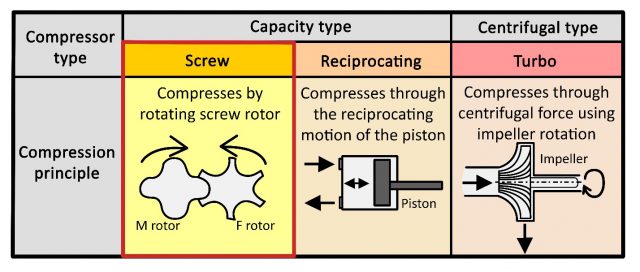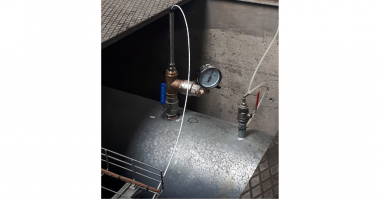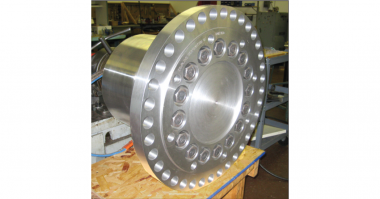Author: Robert X. Perez, Machinery Engineer
In this series of columns, I am explaining the basics of compressor selection. In part 2 of this series, I explained how to calculate gas flow in terms of actual cubic feet per minute (ACFM). Now, I will introduce the GPSA “Compressor Coverage Chart” and discuss how it can be used to identify possible compressor design candidates given a set of design conditions.
Compressor Selection Example:
Let’s assume the following design conditions:
• Flow is 3161.4 scfm
• The gas enters the compressor at 200 psia and 100 oF
• The compressor discharge is 1050 psig
The first step is to convert the SCFM flow to ACFM at the compressor’s inlet. We will assume z=1:

In this example, our ACFM =250 acfm.
The next step in our selection process is to plot the calculated ACFM flow and discharge pressure point on the “Compressor Selection Chart” in Figure 2. Notice that design points may fall into multiple compressor selection regions.
*Note: The “Compressor Selection Chart” is based on the GPSA “Compressor Coverage Chart” from the Twelfth Edition, 2004. The chart presented here has been simplified to only include screw, reciprocating, and centrifugal compressors.
The final step is to determine which compressor types are viable for your application. Looking at Figure 3, we can see that the point for 250 ACFM and 1050 psig discharge pressure falls inside the multistage reciprocating and single stage centrifugal compressor design envelops.
The next consideration is the differential pressure requirement for the compressor (Table 1). Because a reciprocating compressor can generate a compression ratio (Pdischarge/Psuction) of 3.5 to 4 per stage, higher pressure spreads are possible. However, a centrifugal compressor can only develop a compression ratio of about 1.2 per stage, depending on the gas density. Since this application requires a compression ratio of (1050+14.7)/(200+14.7)=4.96, we can conclude it is not possible to meet our requirements with either a single stage reciprocating or centrifugal compressor. Therefore, we should only consider the multistage compressor for this specific application.

Figure 2: Compressor Selection Chart for various compressor designs. Note: (1) Based on GPSA “Compressor Coverage Chart, Twelfth edition, 2004

Figure 3: Compressor Selection Chart with an example application: 250 acfm with a discharge pressure of 1050 psig. Note: (1) Based on GPSA “Compressor Coverage Chart, Twelfth edition, 2004
Table 1: Here are some compression ratio limits for various types of compressors:
| Compressor Type | Typical Range of Design Compression Ratios |
| Lobe blower | 1 to 2.0 |
| Screw-dry helical compressor | 2 to 5.0 |
| Screw-flooded compressor | 2 to 5.0 |
| Single stage centrifugal compressor | Up to 1.2 |
| Multistage centrifugal compressor | Up to 3 |
| Axial compressor | 4 to 27 |
| Non-lubrication reciprocating compressor | Up to 3.5 per stage |
| Lubricated reciprocating compressor | Up to 3.5 per stage |
Let’s look at another example. Let’s assume that we have calculated the ACFM flow to be 20,000 acfm and we know the discharge pressure is going to be 900 psig. If we look over the “Compressor Selection Chart” we will see that the only viable option is the Multistage Compressor (Figure 4).

Figure 4: Compressor Selection Chart with an example application: 2000 acfm with a discharge pressure of 900 psig.
Next time, I will finish my series of columns by providing an alternative method of compressor selection and then end with a quick review of the compressor selection process.
About the Author
 Robert Perez is mechanical engineer with more than 35 years of rotating equipment experience in the petrochemical industry. He has worked in petroleum refineries, chemical facilities, and gas processing plants. He earned a BSME degree from Texas A&M University at College Station, an MSME degree from the University of Texas at Austin, and holds a Texas PE license.
Robert Perez is mechanical engineer with more than 35 years of rotating equipment experience in the petrochemical industry. He has worked in petroleum refineries, chemical facilities, and gas processing plants. He earned a BSME degree from Texas A&M University at College Station, an MSME degree from the University of Texas at Austin, and holds a Texas PE license.
Mr. Perez has written numerous machinery reliability articles for magazines and conferences proceedings and has authored 4 books and coauthored 4 books related to machinery reliability. He resides in San Antonio, Texas.





Comments